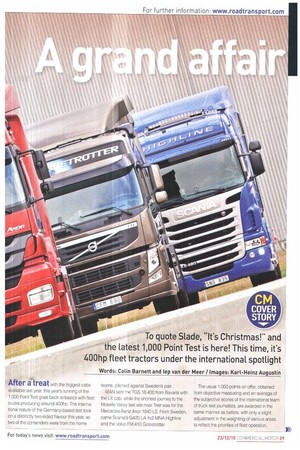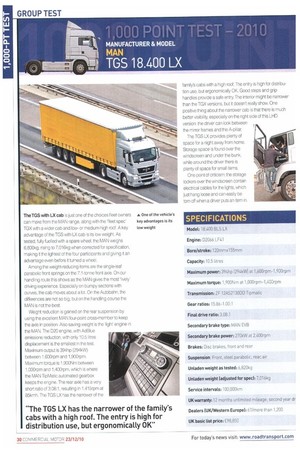To quote Slade, "Ifs Christmas!" and the latest 1,000 Point
Page 29

Page 30

Page 32

If you've noticed an error in this article please click here to report it so we can fix it.
Test is here! This time, its 400hp fleet tractors under the international spotlight
Words: Cohn Barnett and leo van der Meer / Images: Karl-Heinz Augustin After a treat with the biggest cabs available last year, this year's running of the 1,000 Point Test goes back to basics with fleet trucks producing around 400hp. The international nature of the Germany-based test took on a distinctly two-sided flavour this year, as two of the contenders were from the home
teams, pitched against Sweden's par.
MAN sent the TGS 18.400 from Bavaria with the EX cab, while the shortest journey to the Moselle Valley test site near Trier was for the Mercedes-Benz Axer 1840 LS. From Sweden, came Scania's 0420 LA 4x2 MNA Highline and the Volvo FM 410 Globetrotter. The usual 1,000 points on offer, obtained from objective measuring and an average of the subjectve scores of the international team of truck test journalists, are awarded in the same manner as before, with only a sight adjustment in the weighting of various areas to reflect the priorities of fleet operation. 11) TheTGS with LX cab •=1; just one of tine choices fleet owners can make train the MAN range, along with the 'fleet spec' TGX with a wider cab and lowor medium-high roof. A key advantage of the TGS with LX cab is its low weight. As tested, fully fuelled with a spare wheel, the MAN weighs 6.800kg, hsing to 7,016kg when corrected for specif ication, making it the lightest of the four participants and giving it an advantage even before it turned a wheel.
Among the weight-reducing items are the single-leaf parabolic front springs on the 7.1-tonne front axle. On our handling route this shows as the MAN gives the most 'lively' driving experience. Especially on bumpy sections with curves, the cab moves about a lot. On the Autobahn, the differences are not so big, but on the handling course the MAN is not the best.
Weight reduction is gained on the rear suspension by using the excellent MAN four-point cross-member to keep the axle in position. Also saving weight is the 'light' engine in the MAN. The D20 engine, with AdBlue emissions reduction, with only 10.5 litres displacement is the smallest in the test. Maximum output is 394hp (294kW) between 1.600rpm and 1,900rpm. Maximum torque is 1,900Nm between 1,00Orpm and 1,400rpm, which is where the MAN TipMatic automated gearbox keeps the engine. The rear axle has a very short ratio of 3.08:1, resulting in 1,415rpm at 85kmh. The TGS LX has the narrower of the family's cabs with a high roof. The entry is high for distribution use, but ergonomically OK. Good steps and grip handles provide a safe entry. The interior might be narrower than the TGX versions, but it doesn't really show. One positive thing about the narrower cab is that there is much better visibility, especially on the right side of this LHD version: the driver can look between the mirror frames and the A-pillar.
The TGS LX provides plenty of space for a night away from home. Storage space is found over the windscreen and under the bunk, while around the driver there is plenty of space for small items.
One point of criticism: the storage lockers over the windscreen contain electrical cables for the lights, which just hang loose and can easily be torn off when a driver puts an item in.
The Axor is a bit of a strange vehicle in this segment. When we as for "fleet spec for heavy distribution and middleto long-distance haulage", we expect low trucks with an easy entry. The Axor has by far the highest entry of all four and is even higher than the Actros L-Cab. Choosing the Actros L-Cab for this segment would be an option, but it is the pricing that makes big fleets buy Axor trucks.
Still, the Axor has one big advantage in our opinion and that is the straight-six engine. It has a completely different feel to the Merc's V6 engines and we like it very much. Engine response, particularly, is much better and that, combined with the Powershift transmission, puts a smile on every driver's face. The OM 457 LA engine gives 396hp at 1,900rpm and a maximum torque of 2,000Nm at 1,100rpm. The 12-litre engine has unit injectors and five valves per cylinder. Behind the Powershift automated 12-speed gearbox there is a Voith retarder that in this test is calculated out. The rear axle has a ratio of 2.84:1. When it comes to weight, the Axor is the heaviest truck of the four.
The entry is impressive and a bit of an obstacle when you have a lot of drops during a day. Once up in the high-positioned Axor cab everything is up to Actros standards. It's well put together with a high-quality finish, although in a bit of a dull grey colour scheme. The overview of all functions on the dash is good and all switches and gauges are in logical places One typically Mercedes-Benz item is the adjustment for the cruise control. It is operated with the stalk on the right of the steering column and we just can't get used to that one. We would prefer to operate the gearbox from that stalk and to have the cruise control functions on the steering wheel. There is plenty of storage space in the cab, the fridge slides under the bunk and the engine tunnel is low for this segment. The storage boxes outside are way too small on the Axor.
On the road, the Axor's behaviour is not the best on the handling course. The feel through the steering wheel is the worst of the four and there is too much cab movement. On the Autobahn, the Axor is a bit vague around the central point of the steering.
































































































































